
Louse is the common name for members of the order Phthiraptera, which contains nearly 5,000 species of wingless insect. Lice are obligate parasites, living externally on warm-blooded hosts which include every species of bird and mammal, except for monotremes, pangolins, and bats. Lice are vectors of diseases such as typhus.
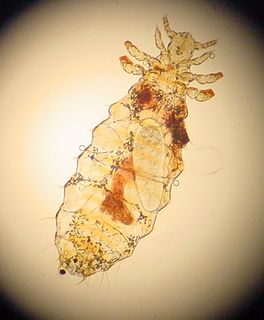
Sucking lice have around 500 species and represent the smaller of the two traditional suborders of lice. As opposed to the paraphyletic chewing lice, which are now divided among three suborders, the sucking lice are monophyletic.

The crab louse or pubic louse is an insect that is an obligate ectoparasite of humans, feeding exclusively on blood. The crab louse usually is found in the person's pubic hair. Although the louse cannot jump, it can also live in other areas of the body that are covered with coarse hair, such as the eyelashes. It is of the order Psocodea.
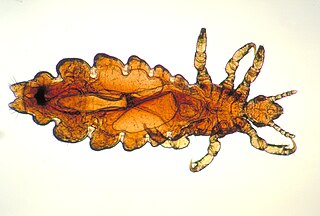
Pediculosis is an infestation of lice. The condition can occur in almost any species of warm-blooded animal, including humans. Although pediculosis in humans may properly refer to lice infestation of any part of the body, the term is sometimes used loosely to refer to pediculosis capitis, the infestation of the human head with the specific head louse.
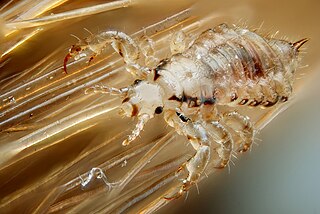
The head louse is an obligate ectoparasite of humans that causes head lice infestation.
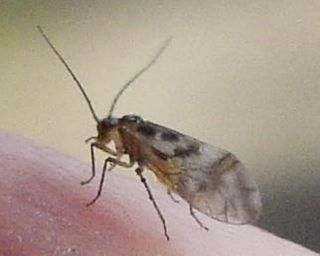
Psocoptera are an order of insects that are commonly known as booklice, barklice or barkflies. They first appeared in the Permian period, 295–248 million years ago. They are often regarded as the most primitive of the hemipteroids. Their name originates from the Greek word ψῶχος, psokhos meaning gnawed or rubbed and πτερά, ptera meaning wings. There are more than 5,500 species in 41 families in three suborders. Many of these species have only been described in recent years.

A sea louse, not to be confused with sea fleas, is a member of a family of copepods within the order Siphonostomatoida, family Caligidae. There are roughly 559 species in 37 genera include around 162 Lepeophtheirus and 268 Caligus species. Sea lice are marine ectoparasites that feed on the mucus, epidermal tissue, and blood of host marine fish.
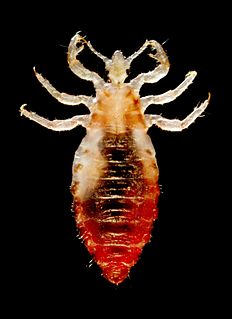
The body louse is a louse that infests humans. The condition of being infested with head lice, body lice, or pubic lice is known as pediculosis. Body lice are vectors for the transmission of the human diseases epidemic typhus, trench fever, and relapsing fever. The body louse genome sequence analysis was published in 2010.
Antonio Suárez Vázquez was a professional road racing cyclist from Spain between 1956 and 1965. He is most famous for winning the overall title and the climbers classification at the 1959 Vuelta a España. In addition, Suarez won the points classification at the 1961 Vuelta and a career total of five stages at the Vuelta.
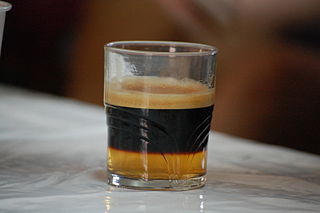
A carajillo is a Spanish drink combining coffee with brandy, whisky, or anisette. It is typical of Spain and according to folk etymology, its origin dates to the times when Cuba was a Spanish province. The troops combined coffee with rum to give them courage.

Psylloidea is a superfamily of true bugs, including the jumping plant lice and others which have recently been classified as distinct families.

Head lice infestation, also known as pediculosis capitis and nits, is the infection of the head hair and scalp by the head louse. Itching from lice bites is common. During a person's first infection, the itch may not develop for up to six weeks. If a person is infected again, symptoms may begin much more quickly. The itch may cause problems with sleeping. Generally, however, it is not a serious condition. While head lice appear to spread some other diseases in Africa, they do not appear to do so in Europe or North America.

Psocodea is a taxonomic group of insects comprising the bark lice, book lice and true lice. It was formerly considered a superorder, but is now generally considered by entomologists as an order. Despite the greatly differing appearance of lice, they are believed to have evolved from within the former order "Psocoptera", which contained the bark lice and book lice. Psocodea contains around 11,000 species, divided among seven suborders.

The salmon louse, Lepeophtheirus salmonis, is a species of copepod in the genus Lepeophtheirus. It is a sea louse, a parasite living mostly on salmon, particularly on Pacific and Atlantic salmon and sea trout, but is also sometimes found on the three-spined stickleback. It lives off the mucus, skin and blood of the fish. They are natural marine parasites of fish such as adult salmon. Once detached they can be blown by wind across the surface of the sea, like plankton. When they encounter a suitable marine fish host they may adhere themselves to the skin, fins, the gills of the fish, and feeding off the mucus or skin. Sea lice only affect fish and are not harmful towards humans.
The 1985–86 ACB season was the 3rd season of the Liga ACB, after changing its name. The sixteen teams were divided in two groups. After playing a double round-robin, the teams are divided again in two groups of eight teams each.

Paraneoptera is a monophyletic superorder of insects which includes four orders, the bark lice, true lice, thrips, and hemipterans, the true bugs. The mouthparts of the Paraneoptera reflect diverse feeding habits. Basal groups are microbial surface feeders, whereas more advanced groups feed on plant or animal fluids.

Círcol Catòlic de Badalona is a basketball club based in Badalona, Spain.
Lice Fabiana Chamorro Gómez is a Paraguayan footballer who plays as a midfielder for Spanish club SC Huelva and the Paraguay women's national team. She is a right-footed left winger.

















